Eight Steps to Becoming a Legendary Hair Metal Guitarist
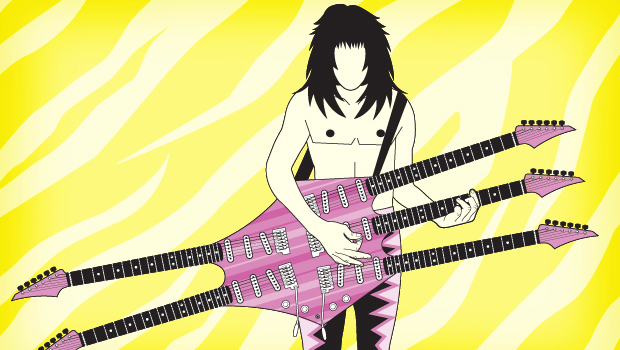
From fashion trends to movie remakes, the Eighties are back with a vengeance.
But are neon-colored Wayfarers and tiger-print bikinis enough to bring back the decade’s most recognizable musical period? It’s unclear at this point, but as the Boy Scouts say, let’s “be prepared.”
It’s impossible to think about Eighties rock without vibrant visuals of half-naked dudes prancing around stage wearing more makeup and hair product than a horde of groupies. Even though the period broke almost every unwritten rule of rock and roll, it became one of its most successful sub-genres.
So, what if this current Eighties revival is stronger than we realize and hair metal rises from the ashes like a Spandex and lace-clad phoenix? You’ll have to jump on the bandwagon and tap/palm mute your way to a record deal. However, being a hair metal guitarist is much deeper than just executing signature techniques. How you look and act is just as important as how you sound.
Below are eight specific rules you’ll need to employ to become the leader of a full-fledged hair metal resurgence.
1. Smile the Entire Time You’re On Stage or Camera
One of glam or hair metal's original the genre’s first nicknames was "teeth metal" because band members smiled so much on stage. This style of rock was all about playing upbeat songs that focused on girls, cars and, well, being happy. There’s no way you can’t smile if you’re basically the Tony Robbins of rock music. Performing a song about the best night of your life with a death stare and clenched jaw kills your credibility.
Plus, a badass, I’ll-break-your-face-if-you-even-look-me-in-the-eye persona is impossible to pull off while wearing makeup and lace gloves. Exception: Don’t smile when performing a ballad. Shed a minimum of three tears instead.
Get The Pick Newsletter
All the latest guitar news, interviews, lessons, reviews, deals and more, direct to your inbox!
2. Guitars Must Have Custom Graphics
By the mid-Eighties, if your guitar didn’t display geometric art that utilized every color in the rainbow, you wouldn’t even be allowed to step on the stage of a high school talent show. However, don’t worry if you lack fine-art skills. You can cheat the rule by blinding fans with sparkly neon or color-shifting chameleon finishes.
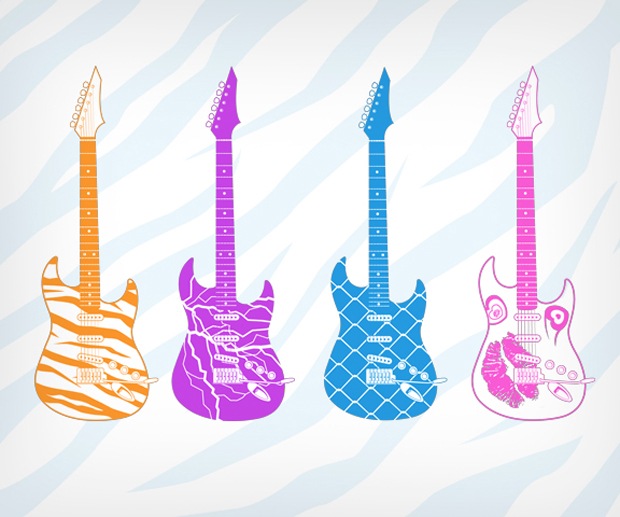
3. Play a "Super Strat"
Almost every hair metal guitarist played a "Super Strat" (with the exception of the custom Flying-V) for three reasons: Eddie did it, it offered easy access to the whammy bar and it was extremely light-weight. You may ask, “What the hell did guitar weight have to do with hair metal?” Everything. Watch an old video or concert footage and you’ll notice the lead guitarist running, jumping, sliding, dancing, crawling, spinning and skipping on stage like a maniac that just swallowed 59 caffeine pills. A heavy axe limits aerodynamics and throws off counterbalance.
4. Hate Your Lead Singer
No explanation needed.
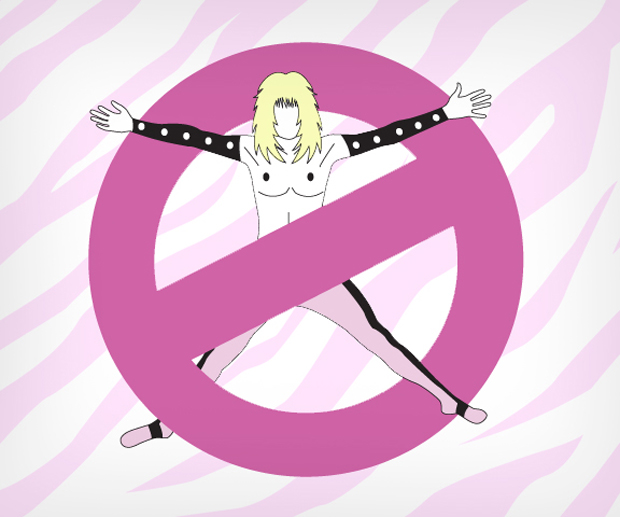
5. Incorporate the Following Techniques Into Every Song:
Transitional Dive Bomb: Instantly executed after the song’s first solo or transition to the chorus, Eighties guitarists were dropping it like it was hot long before Snoop Dog. Although Jimi Hendrix pioneered the technique in the late ‘60s, hair metal popularized dive bombs, instituting a standard presence in almost every recording from the era.
Pinch Harmonics: Pinch harmonics didn’t originate with hair metal but were widely commercialized by the genre. The goal was simple: Create the loudest, highest, most ear-splitting note imaginable. Shortly after they gained popularity, guitarists began combining them with dive bombs to produce an even crazier sequel that resembled a thoroughbred that just inhaled a 10,000-gallon helium tank.
High-String Palm Muting: From “Panama” to “Round and Round,” high-string palm muting is one of hair metal’s most recognizable methods. Muting the G, B and E strings during the bridge gave songs a different kind of sound and complemented the lead singer’s high-pitched voice.
Tapping: Listen to any song from the period and you’ll hear a raging fury of two-handed hammer-ons and pull-offs. Remember, one goal of a hair metal guitarist was to play as many notes per minute as possible. Tapping is an easy way to crank up a solo’s NPMs while looking innovative on stage.
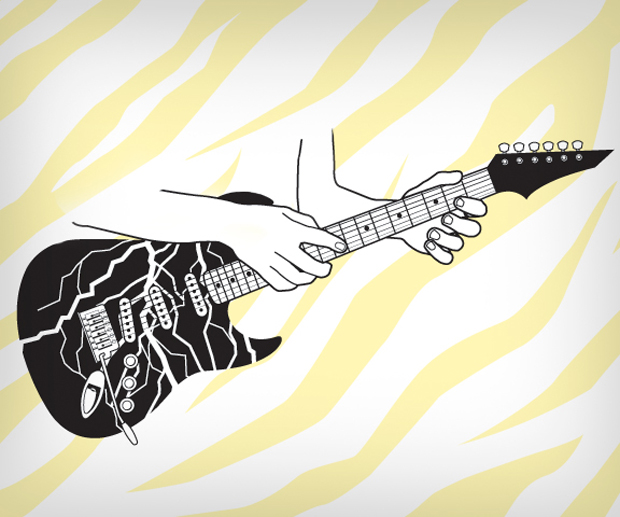
6. Learn How to Play the Synth
I know, this is a guide to becoming an Eighties guitarist. The funny thing is, most songs from the genre contain light synth work. If your song must have a keyboard hook, you want to be the guy playing it. It’s called taking one for the team. I know you’d rather be shredding a hole in your fretboard, but if you don’t tickle the acrylic keys, your lead singer will step up to the challenge. The last thing everyone needs is to add more self-entitlement to his “I am this band” ego.
7. All Headstocks Must Look Like Deadly Weapons
Some say Eighties headstocks were used to scare off stalkers in the crowd. Others say they were meant to remind the lead singer to sleep with one eye open. A few even allege they made it easy to quickly chop up lines in the dressing room. Regardless of the actual reason, to be a true hair metal guitarist, you’ll need to use razor-sharp headstocks that are strong enough to cut through flesh.
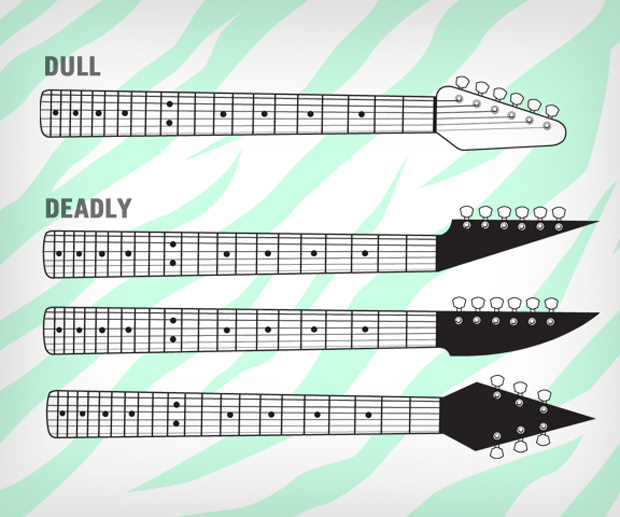
8. During Music Videos, Point at the Camera Before Executing a Trick
A power slide into a ground-level camera and a simple jump off the drum platform were mandatory scenes in every music video. Back then, superb guitar playing wasn’t good enough; guitarists needed to “wow” their fans by performing a stunt during the solo.
To give a “This is slightly dangerous, but I’m going to do it anyway to blow your mind” heads-up to viewers, guitarists always pointed to the camera before executing a low-risk trick. However, a pre-point is not needed if you prefer a post-stunt wink instead.
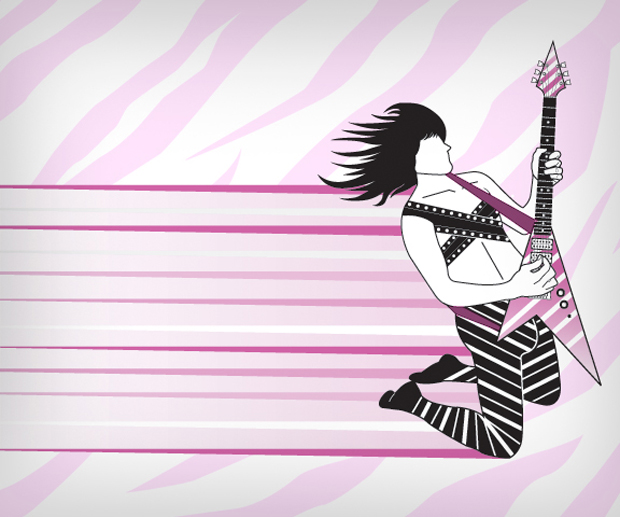
Illustrations: Jordan Hart
Jordan Hart is the author and illustrator of Steel Rainbow: The Legendary Underground Guide to becoming an ‘80s Rock Star (Lyons Press). His spare time is spent collecting albums, designing concert posters, playing the drums excessively loud, split kicking off any elevated surface and shredding on one of his way-too-many guitars. You can follow him on Twitter @Jordan_Hart.
“There’d been three-minute solos, which were just ridiculous – and knackering to play live!” Stoner-doom merchants Sergeant Thunderhoof may have toned down the self-indulgence, but their 10-minute epics still get medieval on your eardrums
“There’s a slight latency in there. You can’t be super-accurate”: Yngwie Malmsteen names the guitar picks that don’t work for shred

![A black-and-white action shot of Sergeant Thunderhoof perform live: [from left] Mark Sayer, Dan Flitcroft, Jim Camp and Josh Gallop](https://cdn.mos.cms.futurecdn.net/am3UhJbsxAE239XRRZ8zC8.jpg)







